Leading Case of Smith v Hughes
VerifiedAdded on 2022/09/15
|7
|1701
|18
AI Summary
Essay questions will be provided along with the pdf files from tutoirals so you can answer there questions. Questions are in the file Essay problem. The structure that the questions must be answered are in the file special topic. The rest of the files are tutorial notes.
Contribute Materials
Your contribution can guide someone’s learning journey. Share your
documents today.
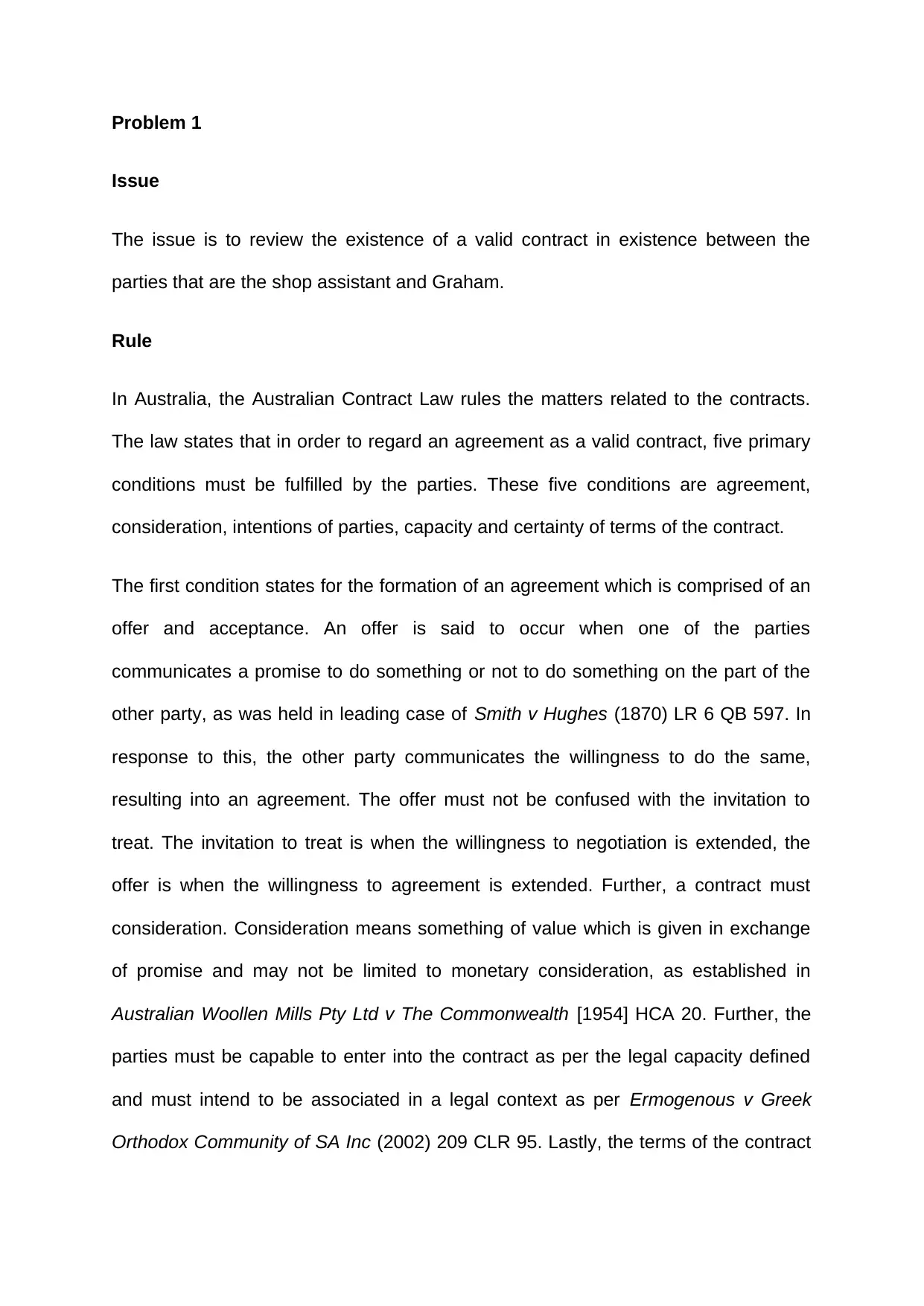
Problem 1
Issue
The issue is to review the existence of a valid contract in existence between the
parties that are the shop assistant and Graham.
Rule
In Australia, the Australian Contract Law rules the matters related to the contracts.
The law states that in order to regard an agreement as a valid contract, five primary
conditions must be fulfilled by the parties. These five conditions are agreement,
consideration, intentions of parties, capacity and certainty of terms of the contract.
The first condition states for the formation of an agreement which is comprised of an
offer and acceptance. An offer is said to occur when one of the parties
communicates a promise to do something or not to do something on the part of the
other party, as was held in leading case of Smith v Hughes (1870) LR 6 QB 597. In
response to this, the other party communicates the willingness to do the same,
resulting into an agreement. The offer must not be confused with the invitation to
treat. The invitation to treat is when the willingness to negotiation is extended, the
offer is when the willingness to agreement is extended. Further, a contract must
consideration. Consideration means something of value which is given in exchange
of promise and may not be limited to monetary consideration, as established in
Australian Woollen Mills Pty Ltd v The Commonwealth [1954] HCA 20. Further, the
parties must be capable to enter into the contract as per the legal capacity defined
and must intend to be associated in a legal context as per Ermogenous v Greek
Orthodox Community of SA Inc (2002) 209 CLR 95. Lastly, the terms of the contract
Issue
The issue is to review the existence of a valid contract in existence between the
parties that are the shop assistant and Graham.
Rule
In Australia, the Australian Contract Law rules the matters related to the contracts.
The law states that in order to regard an agreement as a valid contract, five primary
conditions must be fulfilled by the parties. These five conditions are agreement,
consideration, intentions of parties, capacity and certainty of terms of the contract.
The first condition states for the formation of an agreement which is comprised of an
offer and acceptance. An offer is said to occur when one of the parties
communicates a promise to do something or not to do something on the part of the
other party, as was held in leading case of Smith v Hughes (1870) LR 6 QB 597. In
response to this, the other party communicates the willingness to do the same,
resulting into an agreement. The offer must not be confused with the invitation to
treat. The invitation to treat is when the willingness to negotiation is extended, the
offer is when the willingness to agreement is extended. Further, a contract must
consideration. Consideration means something of value which is given in exchange
of promise and may not be limited to monetary consideration, as established in
Australian Woollen Mills Pty Ltd v The Commonwealth [1954] HCA 20. Further, the
parties must be capable to enter into the contract as per the legal capacity defined
and must intend to be associated in a legal context as per Ermogenous v Greek
Orthodox Community of SA Inc (2002) 209 CLR 95. Lastly, the terms of the contract
Secure Best Marks with AI Grader
Need help grading? Try our AI Grader for instant feedback on your assignments.
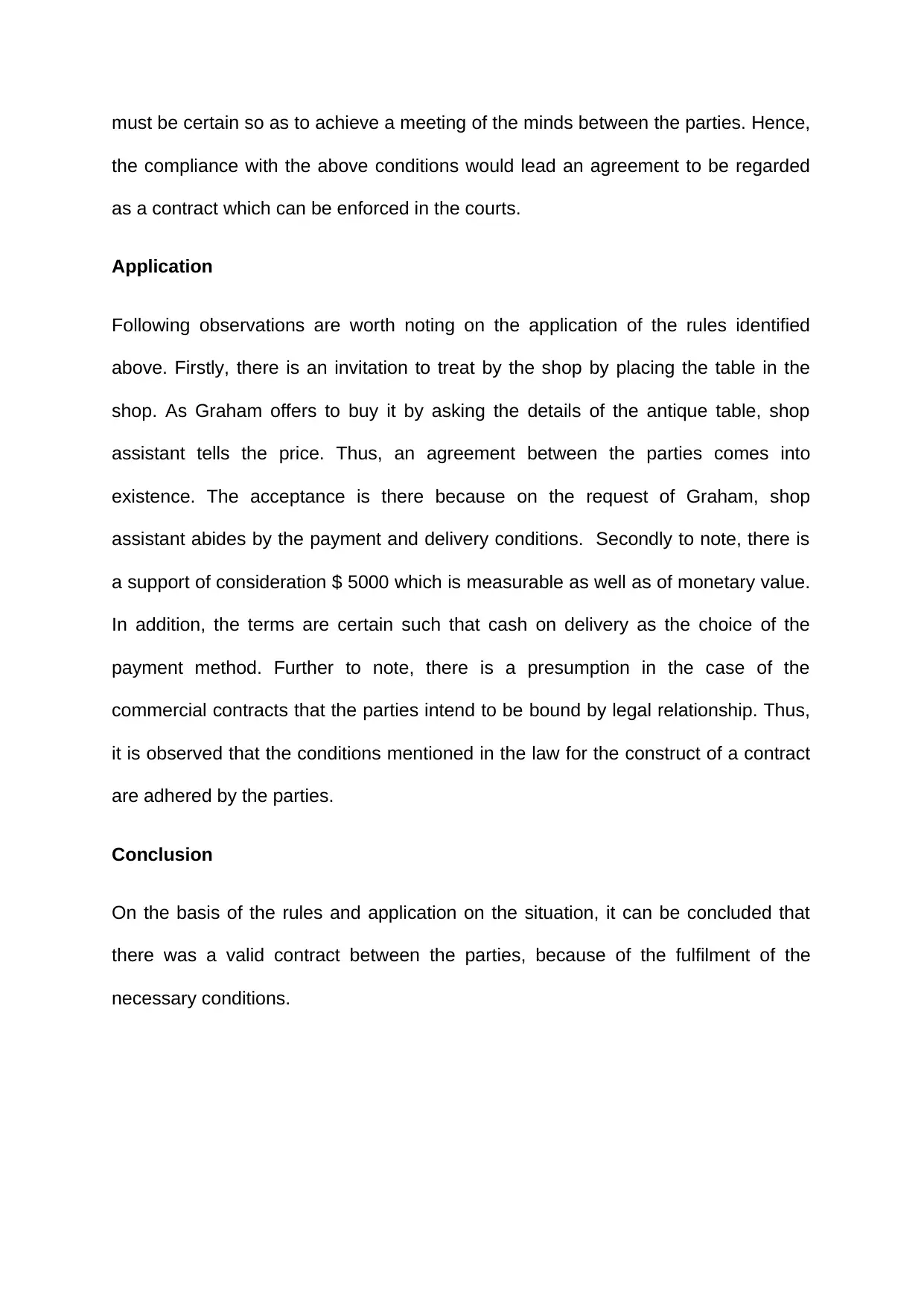
must be certain so as to achieve a meeting of the minds between the parties. Hence,
the compliance with the above conditions would lead an agreement to be regarded
as a contract which can be enforced in the courts.
Application
Following observations are worth noting on the application of the rules identified
above. Firstly, there is an invitation to treat by the shop by placing the table in the
shop. As Graham offers to buy it by asking the details of the antique table, shop
assistant tells the price. Thus, an agreement between the parties comes into
existence. The acceptance is there because on the request of Graham, shop
assistant abides by the payment and delivery conditions. Secondly to note, there is
a support of consideration $ 5000 which is measurable as well as of monetary value.
In addition, the terms are certain such that cash on delivery as the choice of the
payment method. Further to note, there is a presumption in the case of the
commercial contracts that the parties intend to be bound by legal relationship. Thus,
it is observed that the conditions mentioned in the law for the construct of a contract
are adhered by the parties.
Conclusion
On the basis of the rules and application on the situation, it can be concluded that
there was a valid contract between the parties, because of the fulfilment of the
necessary conditions.
the compliance with the above conditions would lead an agreement to be regarded
as a contract which can be enforced in the courts.
Application
Following observations are worth noting on the application of the rules identified
above. Firstly, there is an invitation to treat by the shop by placing the table in the
shop. As Graham offers to buy it by asking the details of the antique table, shop
assistant tells the price. Thus, an agreement between the parties comes into
existence. The acceptance is there because on the request of Graham, shop
assistant abides by the payment and delivery conditions. Secondly to note, there is
a support of consideration $ 5000 which is measurable as well as of monetary value.
In addition, the terms are certain such that cash on delivery as the choice of the
payment method. Further to note, there is a presumption in the case of the
commercial contracts that the parties intend to be bound by legal relationship. Thus,
it is observed that the conditions mentioned in the law for the construct of a contract
are adhered by the parties.
Conclusion
On the basis of the rules and application on the situation, it can be concluded that
there was a valid contract between the parties, because of the fulfilment of the
necessary conditions.
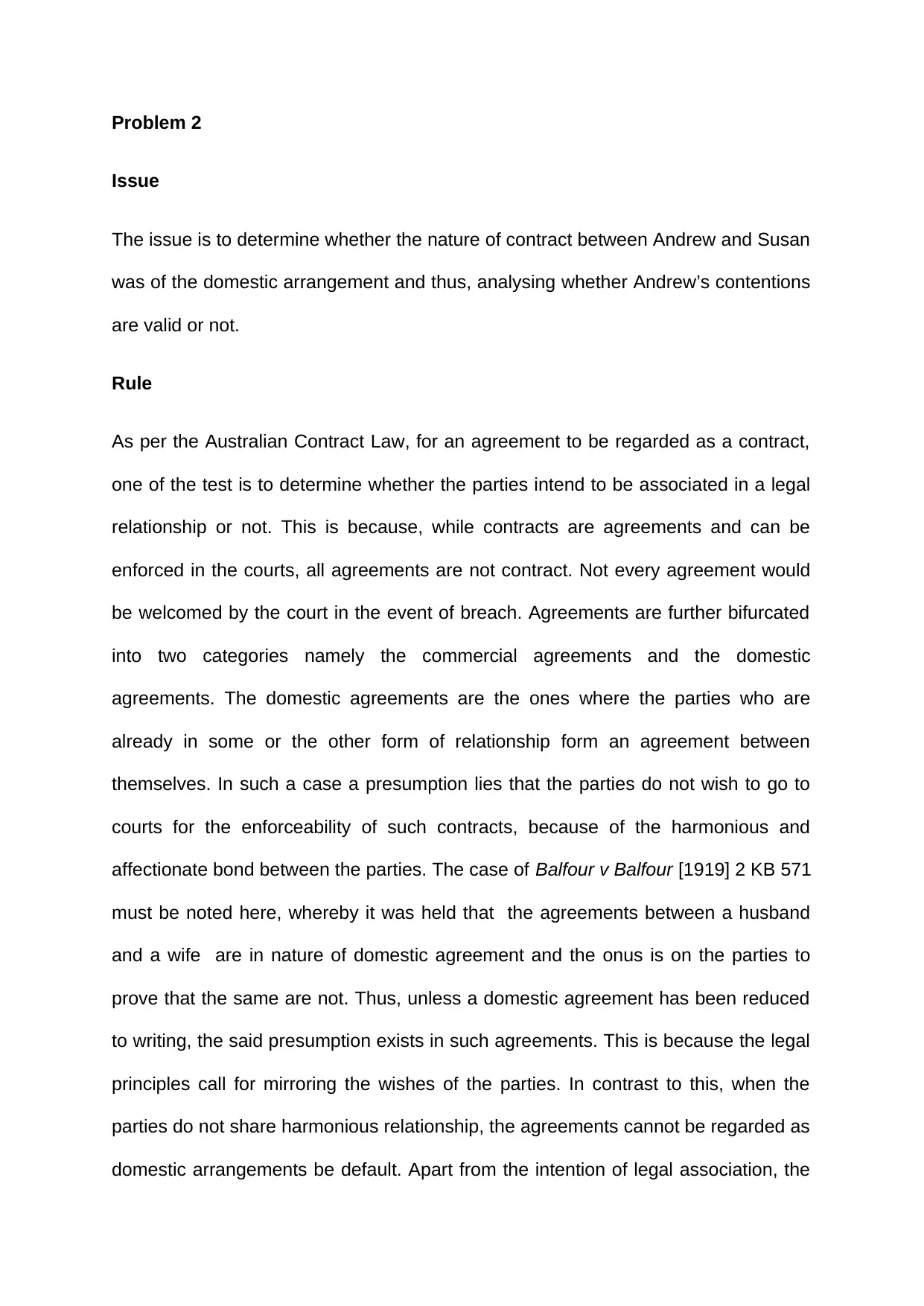
Problem 2
Issue
The issue is to determine whether the nature of contract between Andrew and Susan
was of the domestic arrangement and thus, analysing whether Andrew’s contentions
are valid or not.
Rule
As per the Australian Contract Law, for an agreement to be regarded as a contract,
one of the test is to determine whether the parties intend to be associated in a legal
relationship or not. This is because, while contracts are agreements and can be
enforced in the courts, all agreements are not contract. Not every agreement would
be welcomed by the court in the event of breach. Agreements are further bifurcated
into two categories namely the commercial agreements and the domestic
agreements. The domestic agreements are the ones where the parties who are
already in some or the other form of relationship form an agreement between
themselves. In such a case a presumption lies that the parties do not wish to go to
courts for the enforceability of such contracts, because of the harmonious and
affectionate bond between the parties. The case of Balfour v Balfour [1919] 2 KB 571
must be noted here, whereby it was held that the agreements between a husband
and a wife are in nature of domestic agreement and the onus is on the parties to
prove that the same are not. Thus, unless a domestic agreement has been reduced
to writing, the said presumption exists in such agreements. This is because the legal
principles call for mirroring the wishes of the parties. In contrast to this, when the
parties do not share harmonious relationship, the agreements cannot be regarded as
domestic arrangements be default. Apart from the intention of legal association, the
Issue
The issue is to determine whether the nature of contract between Andrew and Susan
was of the domestic arrangement and thus, analysing whether Andrew’s contentions
are valid or not.
Rule
As per the Australian Contract Law, for an agreement to be regarded as a contract,
one of the test is to determine whether the parties intend to be associated in a legal
relationship or not. This is because, while contracts are agreements and can be
enforced in the courts, all agreements are not contract. Not every agreement would
be welcomed by the court in the event of breach. Agreements are further bifurcated
into two categories namely the commercial agreements and the domestic
agreements. The domestic agreements are the ones where the parties who are
already in some or the other form of relationship form an agreement between
themselves. In such a case a presumption lies that the parties do not wish to go to
courts for the enforceability of such contracts, because of the harmonious and
affectionate bond between the parties. The case of Balfour v Balfour [1919] 2 KB 571
must be noted here, whereby it was held that the agreements between a husband
and a wife are in nature of domestic agreement and the onus is on the parties to
prove that the same are not. Thus, unless a domestic agreement has been reduced
to writing, the said presumption exists in such agreements. This is because the legal
principles call for mirroring the wishes of the parties. In contrast to this, when the
parties do not share harmonious relationship, the agreements cannot be regarded as
domestic arrangements be default. Apart from the intention of legal association, the
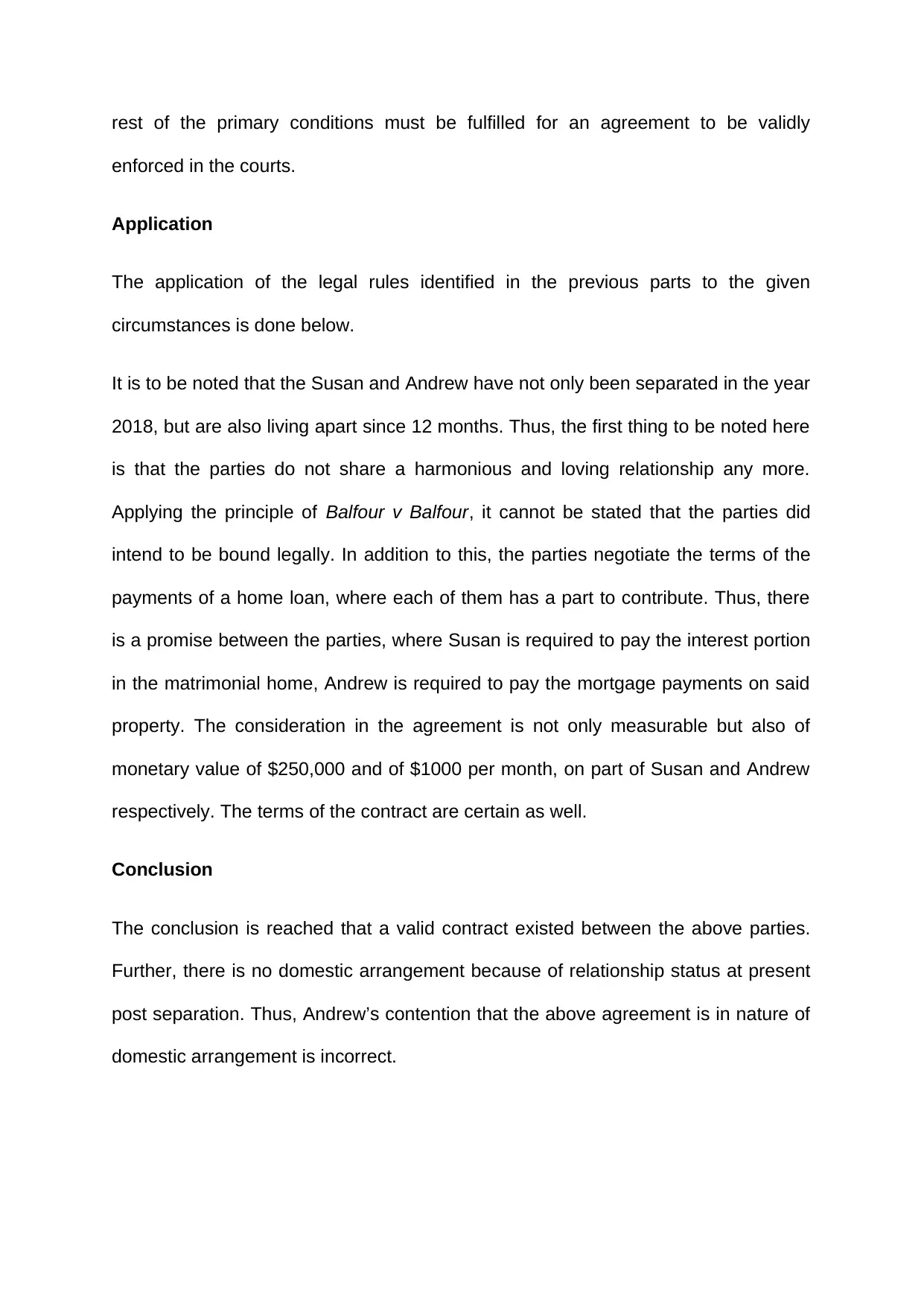
rest of the primary conditions must be fulfilled for an agreement to be validly
enforced in the courts.
Application
The application of the legal rules identified in the previous parts to the given
circumstances is done below.
It is to be noted that the Susan and Andrew have not only been separated in the year
2018, but are also living apart since 12 months. Thus, the first thing to be noted here
is that the parties do not share a harmonious and loving relationship any more.
Applying the principle of Balfour v Balfour, it cannot be stated that the parties did
intend to be bound legally. In addition to this, the parties negotiate the terms of the
payments of a home loan, where each of them has a part to contribute. Thus, there
is a promise between the parties, where Susan is required to pay the interest portion
in the matrimonial home, Andrew is required to pay the mortgage payments on said
property. The consideration in the agreement is not only measurable but also of
monetary value of $250,000 and of $1000 per month, on part of Susan and Andrew
respectively. The terms of the contract are certain as well.
Conclusion
The conclusion is reached that a valid contract existed between the above parties.
Further, there is no domestic arrangement because of relationship status at present
post separation. Thus, Andrew’s contention that the above agreement is in nature of
domestic arrangement is incorrect.
enforced in the courts.
Application
The application of the legal rules identified in the previous parts to the given
circumstances is done below.
It is to be noted that the Susan and Andrew have not only been separated in the year
2018, but are also living apart since 12 months. Thus, the first thing to be noted here
is that the parties do not share a harmonious and loving relationship any more.
Applying the principle of Balfour v Balfour, it cannot be stated that the parties did
intend to be bound legally. In addition to this, the parties negotiate the terms of the
payments of a home loan, where each of them has a part to contribute. Thus, there
is a promise between the parties, where Susan is required to pay the interest portion
in the matrimonial home, Andrew is required to pay the mortgage payments on said
property. The consideration in the agreement is not only measurable but also of
monetary value of $250,000 and of $1000 per month, on part of Susan and Andrew
respectively. The terms of the contract are certain as well.
Conclusion
The conclusion is reached that a valid contract existed between the above parties.
Further, there is no domestic arrangement because of relationship status at present
post separation. Thus, Andrew’s contention that the above agreement is in nature of
domestic arrangement is incorrect.
Secure Best Marks with AI Grader
Need help grading? Try our AI Grader for instant feedback on your assignments.
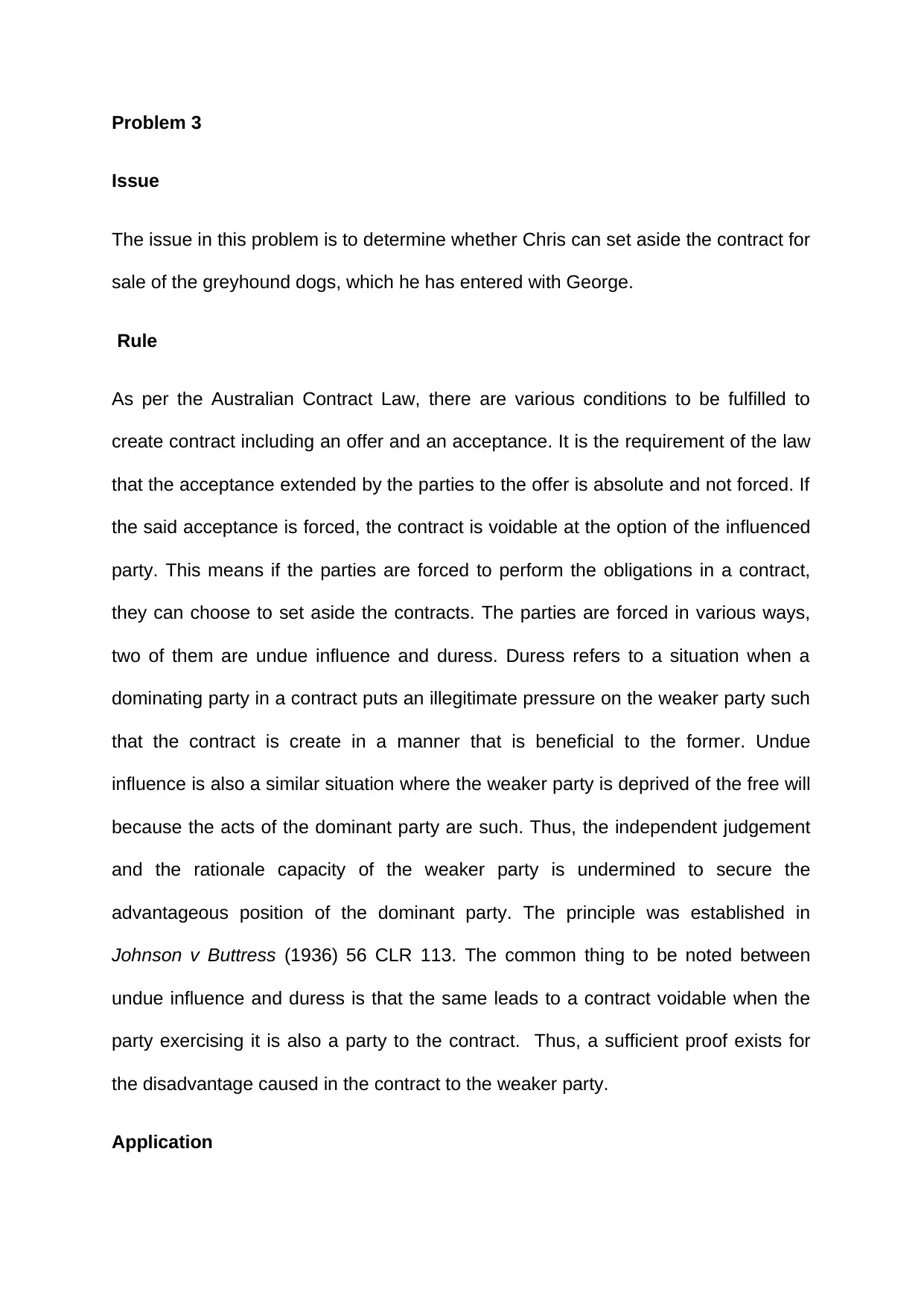
Problem 3
Issue
The issue in this problem is to determine whether Chris can set aside the contract for
sale of the greyhound dogs, which he has entered with George.
Rule
As per the Australian Contract Law, there are various conditions to be fulfilled to
create contract including an offer and an acceptance. It is the requirement of the law
that the acceptance extended by the parties to the offer is absolute and not forced. If
the said acceptance is forced, the contract is voidable at the option of the influenced
party. This means if the parties are forced to perform the obligations in a contract,
they can choose to set aside the contracts. The parties are forced in various ways,
two of them are undue influence and duress. Duress refers to a situation when a
dominating party in a contract puts an illegitimate pressure on the weaker party such
that the contract is create in a manner that is beneficial to the former. Undue
influence is also a similar situation where the weaker party is deprived of the free will
because the acts of the dominant party are such. Thus, the independent judgement
and the rationale capacity of the weaker party is undermined to secure the
advantageous position of the dominant party. The principle was established in
Johnson v Buttress (1936) 56 CLR 113. The common thing to be noted between
undue influence and duress is that the same leads to a contract voidable when the
party exercising it is also a party to the contract. Thus, a sufficient proof exists for
the disadvantage caused in the contract to the weaker party.
Application
Issue
The issue in this problem is to determine whether Chris can set aside the contract for
sale of the greyhound dogs, which he has entered with George.
Rule
As per the Australian Contract Law, there are various conditions to be fulfilled to
create contract including an offer and an acceptance. It is the requirement of the law
that the acceptance extended by the parties to the offer is absolute and not forced. If
the said acceptance is forced, the contract is voidable at the option of the influenced
party. This means if the parties are forced to perform the obligations in a contract,
they can choose to set aside the contracts. The parties are forced in various ways,
two of them are undue influence and duress. Duress refers to a situation when a
dominating party in a contract puts an illegitimate pressure on the weaker party such
that the contract is create in a manner that is beneficial to the former. Undue
influence is also a similar situation where the weaker party is deprived of the free will
because the acts of the dominant party are such. Thus, the independent judgement
and the rationale capacity of the weaker party is undermined to secure the
advantageous position of the dominant party. The principle was established in
Johnson v Buttress (1936) 56 CLR 113. The common thing to be noted between
undue influence and duress is that the same leads to a contract voidable when the
party exercising it is also a party to the contract. Thus, a sufficient proof exists for
the disadvantage caused in the contract to the weaker party.
Application
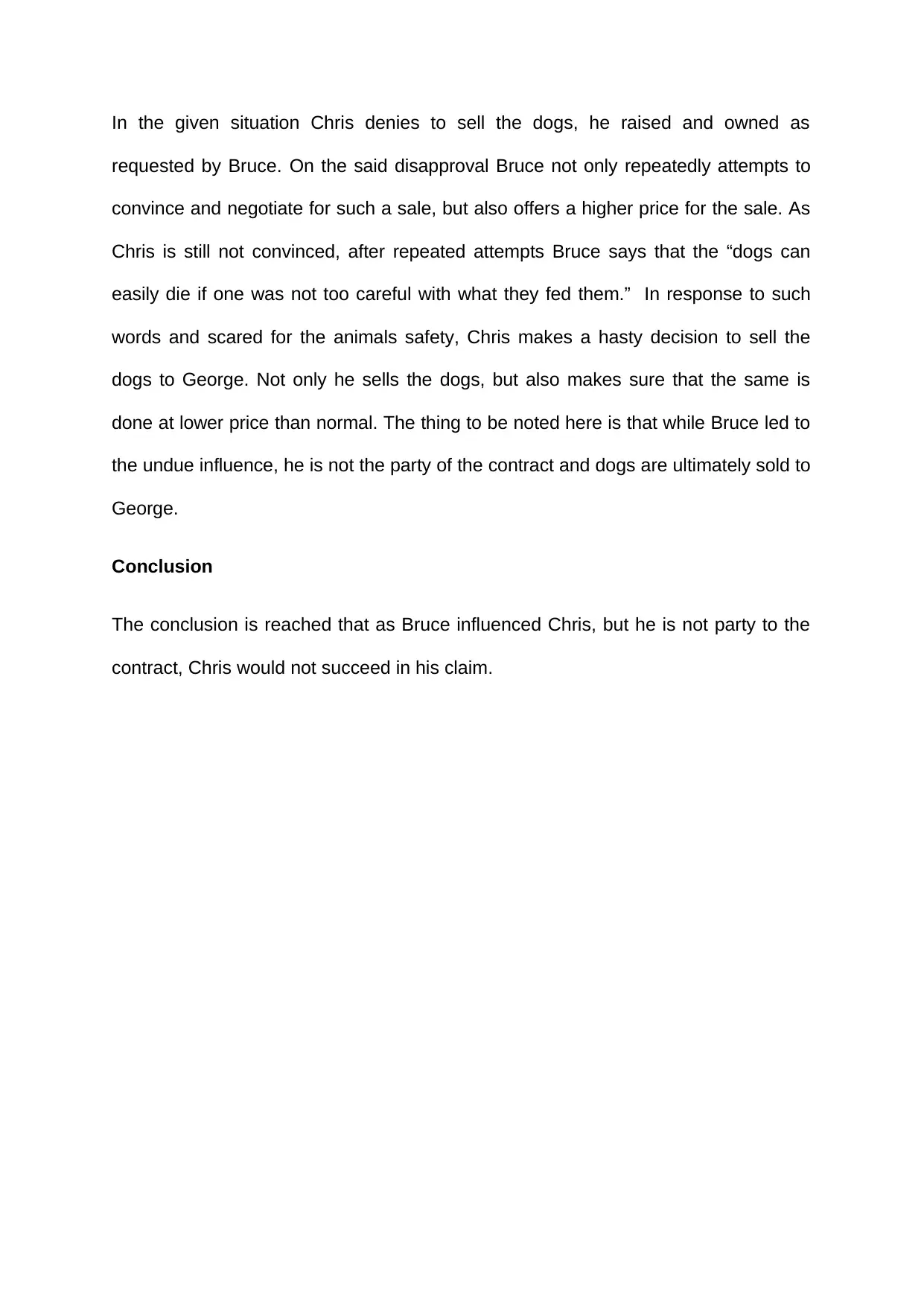
In the given situation Chris denies to sell the dogs, he raised and owned as
requested by Bruce. On the said disapproval Bruce not only repeatedly attempts to
convince and negotiate for such a sale, but also offers a higher price for the sale. As
Chris is still not convinced, after repeated attempts Bruce says that the “dogs can
easily die if one was not too careful with what they fed them.” In response to such
words and scared for the animals safety, Chris makes a hasty decision to sell the
dogs to George. Not only he sells the dogs, but also makes sure that the same is
done at lower price than normal. The thing to be noted here is that while Bruce led to
the undue influence, he is not the party of the contract and dogs are ultimately sold to
George.
Conclusion
The conclusion is reached that as Bruce influenced Chris, but he is not party to the
contract, Chris would not succeed in his claim.
requested by Bruce. On the said disapproval Bruce not only repeatedly attempts to
convince and negotiate for such a sale, but also offers a higher price for the sale. As
Chris is still not convinced, after repeated attempts Bruce says that the “dogs can
easily die if one was not too careful with what they fed them.” In response to such
words and scared for the animals safety, Chris makes a hasty decision to sell the
dogs to George. Not only he sells the dogs, but also makes sure that the same is
done at lower price than normal. The thing to be noted here is that while Bruce led to
the undue influence, he is not the party of the contract and dogs are ultimately sold to
George.
Conclusion
The conclusion is reached that as Bruce influenced Chris, but he is not party to the
contract, Chris would not succeed in his claim.
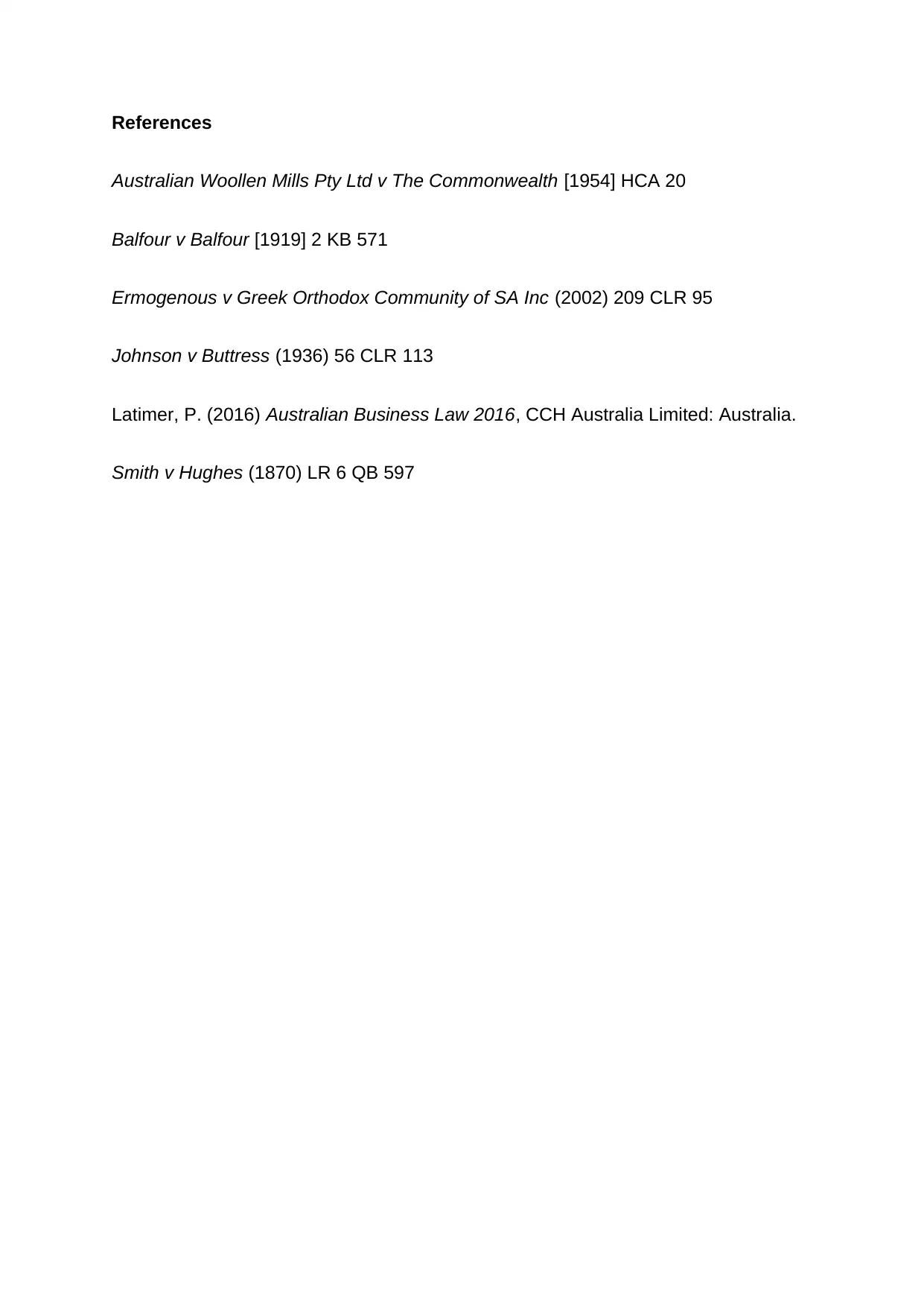
References
Australian Woollen Mills Pty Ltd v The Commonwealth [1954] HCA 20
Balfour v Balfour [1919] 2 KB 571
Ermogenous v Greek Orthodox Community of SA Inc (2002) 209 CLR 95
Johnson v Buttress (1936) 56 CLR 113
Latimer, P. (2016) Australian Business Law 2016, CCH Australia Limited: Australia.
Smith v Hughes (1870) LR 6 QB 597
Australian Woollen Mills Pty Ltd v The Commonwealth [1954] HCA 20
Balfour v Balfour [1919] 2 KB 571
Ermogenous v Greek Orthodox Community of SA Inc (2002) 209 CLR 95
Johnson v Buttress (1936) 56 CLR 113
Latimer, P. (2016) Australian Business Law 2016, CCH Australia Limited: Australia.
Smith v Hughes (1870) LR 6 QB 597
1 out of 7
Related Documents
Your All-in-One AI-Powered Toolkit for Academic Success.
+13062052269
info@desklib.com
Available 24*7 on WhatsApp / Email
![[object Object]](/_next/static/media/star-bottom.7253800d.svg)
Unlock your academic potential
© 2024 | Zucol Services PVT LTD | All rights reserved.





